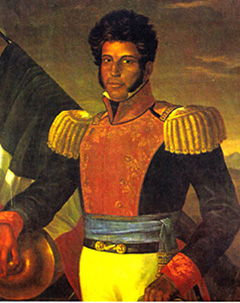African-Indian First Black President in North America
 Mumia Abu-Jamal - San Francisco Bay View Mumia Abu-Jamal - San Francisco Bay View
go to original


| | Born 1782, died in political murder 1831, Guerrero was Commander in Chief of the Mexican army during the last three years of the 1810-1821 war for independence, was member of the three person junta that ruled Mexico for part of 1823-24, and was President 1829 into early 1830. Guerrero was raised in a traditionally Indigenous barrio of Tixtla, state of Guerrero. His ability to speak Indigenous languages helped him politically to push a broad "moreno" dark skinned majority rule for his nation. | | |
The first Black president in North America led Mexico some 173 years ago. Vicente Guerrero - a decorated revolutionary hero - helped write the Mexican constitution.

For much of the U.S. populace, the very idea of a Black president is one so new, so novel, that it forces many people to think of it as if it is barely possible - as if it is the stuff of fiction, not fact. Fiction has indeed been the realm of this idea, as in movies and television series, actors have played the part; but that, of course, is on TV.

Of course, time will tell if that is more than imagination, but for millions of people who share this vast land space we call North America, the idea is neither new nor ground-breaking. That's because there are some 100 million people living in Mexico, and that country had a Black president, albeit briefly, some 173 years ago.

It was during their war for independence from Spain when a warrior emerged, a Black Indian named Vicente Guerrero. In his first battle, he was commissioned a captain. As the independence war raged on, many of the leading revolutionaries were either killed or captured. Guerrero fought on, leading some 2,000 men into the Sierra Madre mountains to continue the fight.

By 1821, the Mexicans were prevailing over the Spanish, and Guerrero was hailed as an incorruptible independence fighter. In 1829 he became president of Mexico, and as scholar William Loren Katz writes in his 1986 book, "Black Indians":

"He began a program of far-reaching reforms, abolishing the death penalty and starting construction of schools and libraries for the poor. He ended slavery in Mexico. Yet, because of his skin color, lack of education and country manner, he was held in contempt by the upper classes in Mexico City."

This president, who had, according to U.S. historian M.H. Bancroft, "a gentleness and magnetism that inspired love among his adherents," was still "a triple-blooded outsider."

Black historian J.A. Rogers summarized Guerrero's striking accomplishments by calling him "the George Washington and Abraham Lincoln of Mexico" (page 48).

Guerrero, who in his youth was an illiterate mule driver, once bitten by the bug of Mexican independence, rose to the highest office in the land.

He learned to read when he was about 40 and helped craft the Mexican Constitution, of which he wrote the following provision: "All inhabitants whether white, African or Indian, are qualified to hold office." He wrote this in 1824, over 30 years before the U.S. Supreme Court's infamous Dred Scott decision, which announced, emphatically, that "a Black man has no rights that a white man is bound to respect," and that Black people weren't, and could never be, citizens of the United States.

In that era of revolution and social transformation, a Black man became president of the second largest country in North America. Today, 178 years later, we still wonder if such a thing is possible.

What does that say about the United States?

Read Mumia's latest book, "We Want Freedom: A Life in the Black Panther Party," winner of the 2005 People's Choice Award, available from South End Press, www.southendpress.org or (800) 533-8478. |



